Face Mountain and Montezuma Head
Gila Bend Mountains, BLM
Click for map.
There is nothing special about Face Mountain. It is just another bump popping out of the landscape. It does, just barely, reach the status of 1000 feet of prominence, but all the bumps in the area seem to hover around that except for Woolsey off in the east which doubles it. But it does have a cool feature. Sticking out of the side of it is the Montezuma Head.


I found an area with a pair of roads into it that was impacted by camping right around the where I thought would be a good take off to go out and climb Face Mountain, so that makes easy parking. I did have to check the roads before driving one. One of them is less than ideal for a low vehicle. It continues past the camping area toward the mountain, so my start is along it. It doesn't get far before joining up with a wash and turning north. Suspecting that is not my route, I take off cross country. I wasn't able to download maps to the level I like and seem to have a lot of voice only signal with 10 second spurts of data for my shiny new pocket computer that has, I suppose, been used a few times as a phone. I have been using a quick and dirty free app called simply "OfflineMaps" that caches everything it downloads, then pointing it at 7.5' and 30' level maps. For now, I only have the course 30' level. I feel like some hard won senses of map reading and following faint trails are quickly ebbing away as I can now just glance and have myself pinpointed on a map. Maybe this low resolution exercise will be good for me. Anyway, there are some little bumps to get over between me and the mountain, so I get to gently climbing.

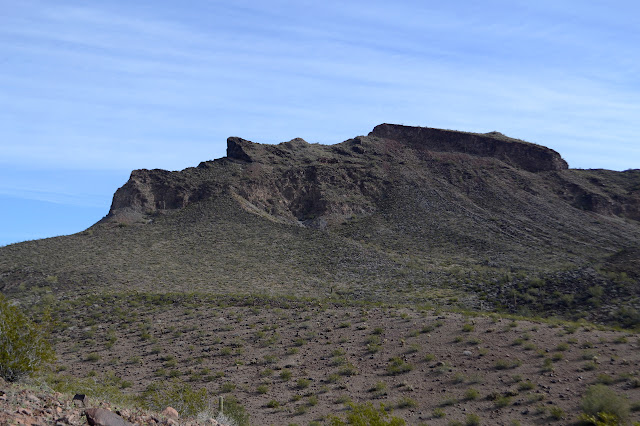

My travel through the hills is made easy by a pair of canyons cutting through them and pointing in my direction. I go up one and down the other. Something is glinting on one of the higher hills to the south and I wonder what it might be. Not enough to go climbing for it. The climb I am going for is steep, but not bad. I am not so happy about the amount of cholla it brings me to. The lower levels have very little of the stuff, although it must still be looked for. Up high, I am looking for the paths wide enough to walk through comfortably instead.



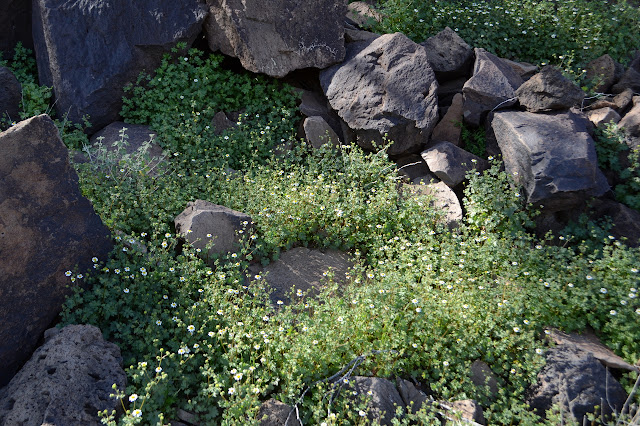
There is an abrupt flattening of my path as I come near the top. There almost seems to be a trail along the way. It is almost certainly sheep or deer, if there is. It hangs vaguely to the right of the small bumps on the way to the local high point.

Surveyors have been to the top. There is a MacLeod and Lilley register that calls this the high point. They are quickly corrected by Bob Packard, who has been a signer on most of these, that they high point is the north peak. Quickly in this case means in the next entry, which is over 6.5 years later. The register tells me about the benchmark, which is not on my low resolution maps. I was hoping to augment them, but none of the mass of antennas on the top of Oatman Mountain to the south is willing to let me use a data connection. The benchmark says "RS 1925" on it, which could be the date it was set, or the date the original it replaces was set. The reference marks are still just chiseled crosses, so it is probably the date it was set. Much later, and those would have been given disks too. When I find them, I am surprised at how dark they have become.


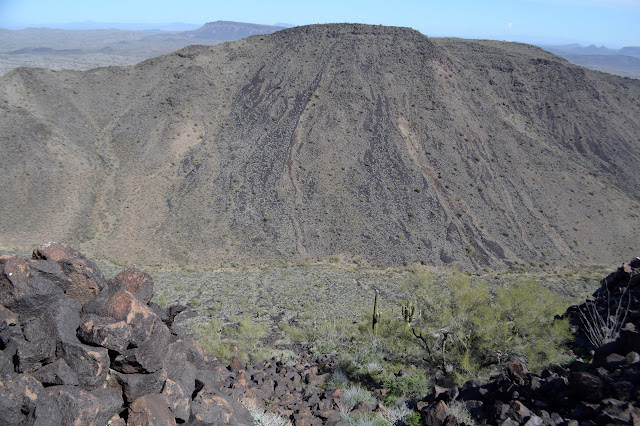
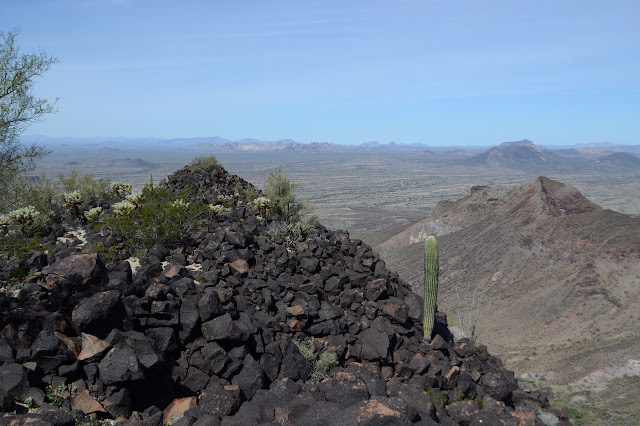

Having not improved my map any, I don't know that the mountain actually has a second benchmark on the east end. I start down the very steep north side of the mountain and carefully hop the rocks down. It takes a long time to be sure of being steady with each step. It is nice to see the cholla thin out, but not so nice to start to be able to resolve that the south side of the peak is also a great place to grow a lot of happy cholla. Once at the bottom, I just start up again. Halfway, my attention is suddenly diverted by a lizard. It is another one that is new to me, although not quite so obviously new as the chuckwalla.


A bit more climbing, briefly pondering the shapes the blocks of once magma have hardened into including one that seems to have once been a roof of a tunnel, and I am at the top again. Sticking to the edge of the scar left by flowing water or rock makes getting past cholla easier. There just aren't as much there. I come out quite close to the top and there is another register.

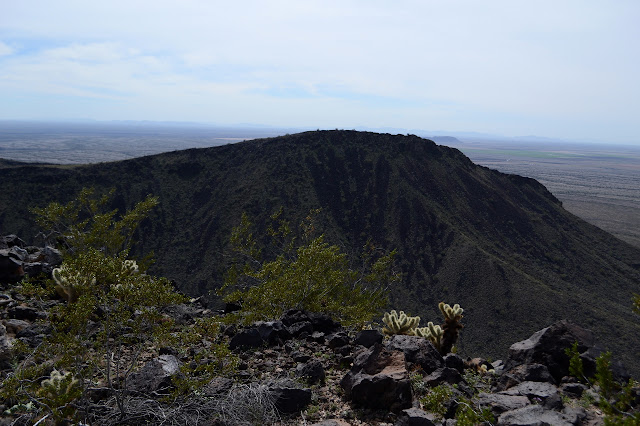
Now there is simply the cholla gauntlet that is the ridge to navigate to get down to the Montezuma Head. A lot of the way, the cholla seems to avoid an area on the top of near the top. Some places, it is a little harder to get by. Sometimes there seems to be a trail along the way. Once at the saddle between the peaks, trail up starts to be a little more established. The ridge narrows down and I need my hands once or twice to go up before it climbs gently again. The easy travel spot for avoiding cholla is right next to the cliff off the north side. Hope the rocks don't fail. A little further off, there are cliffs to the south. There is a small cairn with another register, then it all drops down quite suddenly.



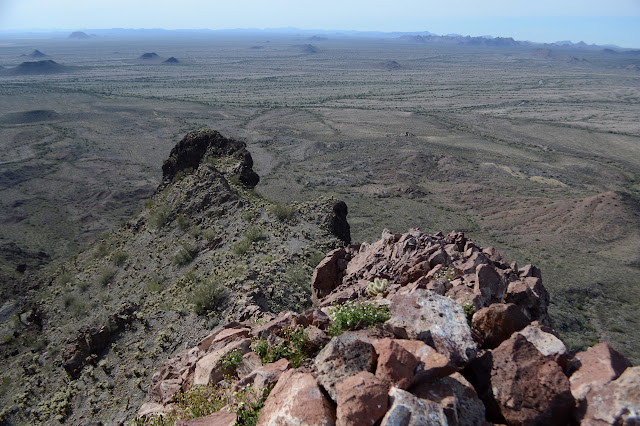
It looks a bit like people do scramble up to the high point from the other side. It doesn't look like something I want to try. I have already picked out a route back the way I came to the saddle, then along the bottom of the cliffs going west until there is slope below me instead of cliffs, then downward as I see fit. So I head back along the top of the cliff and then along the bottom of other cliffs.

I start to regret my route choice as I walk along under the cliff. It wouldn't take quite as big a rock fall at to produce an unpleasant moment when below the cliff than when above it. Still, the rocks seem rather solid for the moment. Less solid is the bit of downhill that is below them once I have passed the cliff bands. But slow and careful and I am down onto some easy stuff with a few short passes to cross to get back.


My trek back is nearly uneventful and even easier than it looked while I was plotting it. Then there is a piece of electronics smashed upon the ground. It is a curious thing with antenna to send and a strip of sensors that seems to contain at least two thermocouples. Six soldered batteries lie nearby. It looks like some sort of single use weather sensor. It has no return address, but I pack it away. It certainly doesn't belong out here.
©2019 Valerie Norton
Written 13 March 2019
Liked this? Interesting? Click the three bars at the top left for the menu to read more or subscribe!




Comments